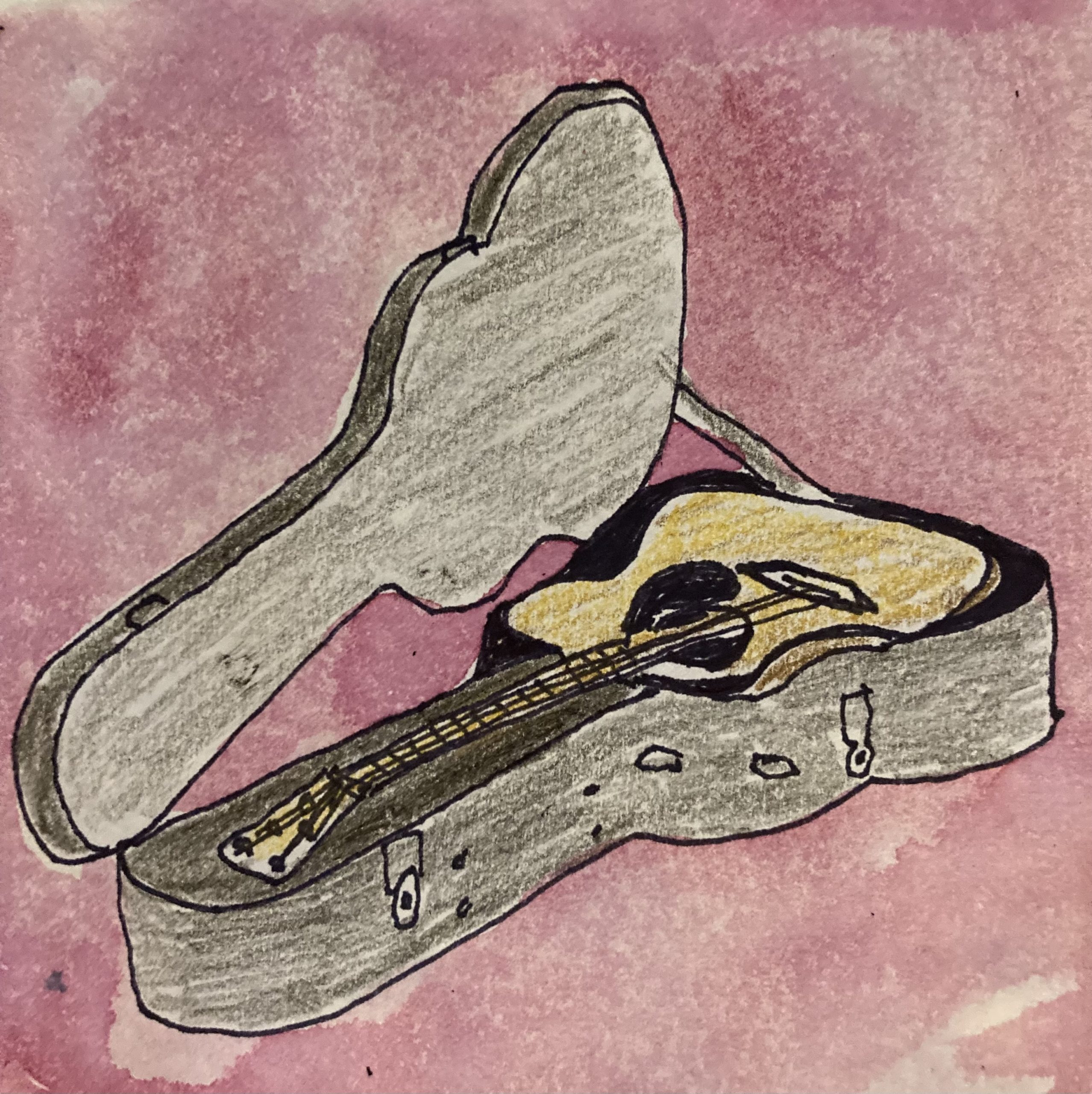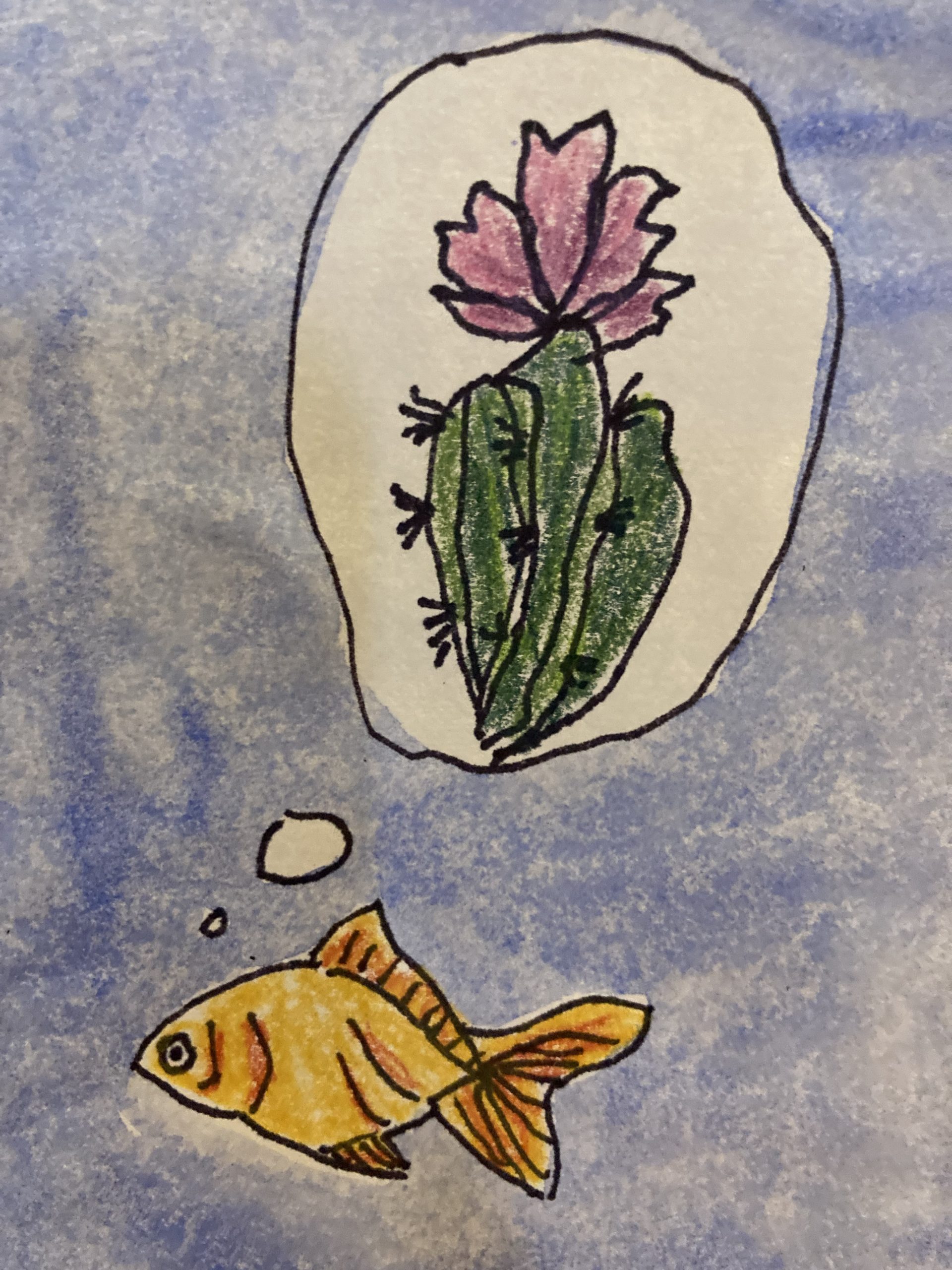Before I traveled to Smith Island, I scoped it out on Apple maps. Sitting ten miles off the coast of Maryland’s eastern shore in the Chesapeake Bay, the island appeared striped: all of its green land split by blue creeks and marshes that slowly, each year, creep in on the land. It looked like a thousand pieces of a puzzle, as if you could push one piece closer to the next to close up the spots where the water takes over. When I visited, I traveled by ferry to Ewell, one of three small towns on Smith Island, and watched as the island appeared on the horizon in pieces, like giant rocks plopped into the Bay. The water beat against the sea-level islets, green grasses silvery in the wind. Here, I would see how it felt to step foot on a sinking island.
Smith Island is eroding due to rising sea levels due to climate change. Due to, due to—always something bigger affecting something smaller. The Chesapeake Bay pushes against the jetties and seawalls set up to protect the shorelines, and worn out shacks and broken docks surround the island’s perimeter. Their appearance seemed a constant reminder of outside forces pushing in, in, in, shrinking the inhabitable land. In the last 150 years, Smith Island lost over 3,300 acres of wetlands. At this rate, the 4.83-square-mile island will be completely submerged by 2100.
We docked outside Harborside Restaurant, and the hostess stood at the ready to welcome guests to an already crowded patio. Guests played cornhole on the restaurant’s lawn. Most of my ferry mates went straight to the restaurant for lunch, where they would spend the remainder of their time before the ferry would take us back to, what the locals call “the Other Side” in Crisfield, Maryland. More adventurous tourists cruised around town in rented golf carts. I opted to walk the dirt path around Ewell—which took about 20 minutes in its entirety.
The island grew quieter past the restaurant. Alone on the gravel road, I passed a church, another church, another restaurant, a general store, a museum that put to rest different myths about the island (no, not everyone shares the same last name, and no, it is not home to a religious cult), and a cake shop that sold Smith Island’s famous multi-layer cake, which became Maryland’s state dessert in 2008. The rest was small homes, shacks, and wharf-like buildings, all slightly worn and stoic. Beyond chain link fences, the houses had the curtains drawn.
Locals told me there was an official “no noise” rule for Sundays. I started to notice that, besides the restaurant, only tourists were outside; all of us spectators, trying to envision a life as simple and removed as this. I could almost feel all of our foreign footprints on the gravel—all our new feet weighing the island down, as if we were pushing it further and further into the Bay.
At the time I visited I lived in Washington, D.C., a city that rarely experiences any climate-induced phenomena, apart from hotter summers and heavier rains. But before I moved to D.C., I lived in Utah, where climate-induced wildfires ravaged mountains and the mansions built high on the slopes. I had seen firsthand the slow and steady destruction caused by existential threats. We learned to live with imminent disaster—it became a part of the landscape, a part of the culture, even. I understood, however much I could, the cognitive dissonance it took to live on a piece of land threatened by disappearance.
Proximity to disaster is inevitable. Death looms in the back of our minds—even stronger now as climate change brings on more chaotic weather patterns, and more forceful hurricanes, tornadoes, tsunamis, and earthquakes that could take out what we know as home. We know that we have to live with this, and we know the more dangerous areas, too: the coasts and the mountains. Yet, we build close to this danger anyway. It’s a status symbol: huge mansions on coastal hills, houses at the peaks of mountains, looking out over the valleys. It’s also a necessity: someone has to move to New Orleans for work, despite the fact that its shoreline is eroding at the same rate as Smith Island’s; it, too, will be gone by 2100. We know this, but people move to these places anyway. Sometimes the knowledge that life is entropy is the best excuse—we accept that we are always in a threatened state.
As a teenager in Utah, I didn’t look at the mountains on fire and feel existential dread. I didn’t expect Elizabeth Landon, the pastor’s daughter who works in Smith Island’s museum and general store, to feel that dread, either. She sat behind the museum counter with two of the island’s three other teenagers, all of them skeptical at my questions. The museum was small; speakers played the audio to a Smith Island documentary, giving us a soundtrack of dramatic piano music. We moved to the back room, and Elizabeth took the lead in answering my questions. Her family used to live on Tilghman Island, another island in the Chesapeake, but one that has a car-accessible bridge to mainland Maryland. The Landons moved to Smith Island because Elizabeth’s father had the opportunity to be the pastor in Ewell, where he had grown up. Elizabeth was not fond of the island—nothing to do, nowhere to go, no way to get there even if there were somewhere to go, and she’s homeschooled, which separates her even further from the community she craves.
“My parents always say they wish I was growing up in their time,” she said. “There was a lot more kids and lot more happening. Like over there,” she pointed to a leaning, dilapidated shack across the road. “That was Rooks—young kids and adults used to hang out there, have parties… a lot more people lived here. It was lively.”
Elizabeth said some houses have been demolished, bushes now grown over the abandoned lots. Grass covers old paths her dad used to ride on his motorcycle. But still, new people are moving onto the island, despite its depletion—some for retirement, to live out their last days away from the rush of the Other Side; some took up summer residencies. National Geographic listed Smith Island as a must-see place to visit in 2016. But even as the population and tourists increased, Ewell’s appearance didn’t reflect this growth. There was only so much land available, and as far as I could tell, no new houses were being built. But the people moving or visiting didn’t come for novelty or opportunity; they came looking for peace, for a bygone era of simple community.
“The nature,” Shawn McCreary, an employee at the local cake and gift shop, cited as the reason he’d moved to Smith Island from Delaware. “You can go out to Rhodes Point, and it’s just emerald green marsh fields on each side, and birds… but if you go out there at night, it’s pitch black. And you can see the Milky Way—it’s like a planetarium.” He didn’t know he missed birds and sky until all he could see were birds and sky.
It’s this nature, this life, the stars, the water, the herons and egrets and ibises perched on half-sunk abandoned buildings, along with the old-style way of living that draws people to Smith Island. It’s an example of the world before we took it over; here, nature wins. Nature is elevated. Life is slow, allowing for people to see what living can feel like without all the noise. Residents make a living off crabbing, fishing, oystering, water-fowl hunting, and by selling Smith Island Cake. They still have internet and television and phones, but the lack of cars, industrial buildings, and virtually any unnatural interruption allows for a quiet, back-to-one’s-roots way of life. The island represents the type of society that we might lean toward in a carbon-neutral world. People walk or bike or drive electric golf carts. On this island there are no factories producing enormous amounts of waste, no coal mines, no oil refineries, no factory farms. And yet, this island still bears the brunt of climate change. The world is more connected than we want to believe—the U.S.’s massive carbon emissions don’t just affect the United States. It’s a great human irony that we poison nature and then run elsewhere to find it again. Of course this will bite us at some point.
The sinking of Smith Island has been documented in articles, books, blogs, and film. So, as I hedged around what I really wanted to ask—how the people I interviewed felt about living on a sinking island—I could tell from the moment they agreed to interview that they expected some version of that question. I felt I needed to level with them, to empathize using the fires I’d witnessed in the past. I didn’t leave Utah because of the threat of disaster, though—rather, I moved for a very common reason: to attend graduate school in another state. I didn’t expect the people of Smith Island to up and move based on a slow and steady threat that won’t fully affect their way of life for another few decades, but I did wonder if they dealt with the threat in any other way than ignoring it.
We know that climate change is real and that it’s moving far faster than at a glacial pace, but for people with little to no individual political power, we can only end our conversations surrounding climate change with thought-terminating cliches: “Well, what can we do?” Or “Only God can save us.” Or “It’s all going to be okay.” Instead of examining, we retreat. Instead of analyzing, we shrug. We have to get back to living: to our jobs, to our kids, to our yards, to the more immediately specific matters that affect our day-to-day lives. I wanted to talk to people about threats, about solutions, about the future of humanity on the Chesapeake’s islands, but the conversation felt forced, like a dead-end attack.
“Would you ever leave?” I asked McCreary. “How do you deal with the fact that the island is sinking?”
“I’m fifty-two,” McCreary said. “It’s not going to happen while I’m alive.”
I found this a common answer. Smith Island’s residents are generally older adults, some whose families have lived there since the 1600s, and also the retirees. I didn’t push too hard about how the erosion might affect younger generations who will witness the island’s disappearance, but the lack of acknowledgement seemed answer enough. Everyone answered for themselves only, like they were in survival mode and didn’t know it.
Freddy, the man who ran the golf cart and bicycle rental, moved to Smith Island as a respite for his wife’s PTSD. He leaned over the counter, and gave short, curt responses, but he also seemed happy to share his opinions. He said they’d likely stay on the island until they physically couldn’t live there any longer. Instead of fearing the eventual disappearance of the island, he acknowledged it would happen, and they’d deal with it then.
He spoke of Eddie Sommers—the president of the preservation initiative, Smith Island United (SIU)—who frequently travels to Washington D.C. to advocate for restoration funds. SIU’s website shows an expansive list of projects—anything from shoreline stabilization to jetty work to drainage studies—funded by various Maryland state agencies. For instance, the rocks lined up on shorelines and cobbled together to look like a stone version of a boardwalk help quell rising tides. They’re not permanent solutions; they fix a symptom rather than the cause. But Freddy is hopeful they’ll prolong his peaceful way of life.
“My wife and I had this conversation the other day,” he said. “You would think they would have something new to combat this a little bit better. But they don’t seem to—it’s all still manpower-whatever-whatever: no new technology.”
While there technically is new carbon-capturing technology that works in a multi-pronged system to combat climate change, I assume Freddy meant on-the-ground actions. And he has a point—there aren’t any great solutions for rising sea levels. He also mentioned mudslides in California, and fires—he gestured to me—in Utah.
“Why would you move there when it’s a given?” he asked, unaware of the irony. “It’s gonna happen in Florida. Louisiana, too. They’ve got hurricanes and floods, so . . . ” He trailed off and we both looked out at the Chesapeake, the water beating against the rocky shoreline.
The difference here is that on Smith Island people are moving closer to an imminent threat, even while understanding the threat isn’t going anywhere, buying property on a sinking island as if somehow theirs will be the lucky house unaffected. While climate change amplifies many disasters, Smith Island is unique in that residents can see it, an up-close intrusion. It’s no wonder they ignore it—we have to forget the possibility of our own demise to live.
“It’ll happen and then you have to leave, and maybe one day we won’t be able to come back. But until then, you know, people my age . . . we’re not going to be around to see these things,” Freddy said.
People his age did see a glimpse of the future, though, as recently as 2013, when Hurricane Sandy’s winds and waves and rain caused flooding and damage to houses and crab shanties and docks. The island’s damage was so bad in some areas that the state proposed a buyout for a few homeowners. But the people refused to leave. The museum outlined Smith Island’s determination to rebuild after this disaster, which is how Smith Island United was born. The plan called for sustaining livelihood, building the local economy, developing infrastructure, expanding transportation, and growing the population—for the next 80 years until the island is vacated and covered by the Chesapeake. While it’s still up for debate how much of a direct impact climate change had on Hurricane Sandy, it’s no secret that climate change exacerbates natural disasters. The hurricane showed a snapshot of what’s to come: walkways underwater, houses flooding, everything gray and cracked and vulnerable.
Worldwide, many have been forced from their land due to climate change; this is not a new story, not even for other islands in the Chesapeake Bay. This same erosion took out Holland Island, which used to stand about ten miles north of Smith Island. Holland Island was also colonized in the 1600s, providing a home to about 300 people. Its demise arrived relatively quickly, though, as by 1914, wind and water had begun to erode the island’s west coast. Islands in the Chesapeake are primarily made up of silt and clay, which reminds me of Jesus’ parable I often heard growing up in Utah: the wise man built his house upon the rock; the foolish man built his house upon the sand. Holland Island’s population tried to move inland for a few years, but the water followed. Many families disassembled their houses, labeled the different pieces, and then rebuilt on the Other Side in Crisfield, Maryland. In 1918, the last family left. From about 1915 to 2005, the island’s land mass was reduced by half, from 160 acres to 80.
A retired Methodist minister named Stephen White visited the remains of Holland Island in the 1990s, and he was shocked at how much the island had morphed since he visited as a child. While looking around an old cemetery, he saw the headstone of a young girl named Effie Wilson that read, “Forget me not is all I ask,” and then he cried for an hour. Determined to answer a ghost’s plea, White bought the island for $70,000 in 1995: embarking on a mission to preserve the un-preservable. He established The Holland Island Preservation Foundation and tried everything he could think of to save the island: He built breakwaters from wood, he laid sandbags near the shore, and he even sunk a barge to try to break the waves. Despite his efforts, after so many years of wind and water disintegrating the island—20 more acres of land had disappeared during his efforts—only one house remained. In photos, the house stands surrounded by water, leaning and gray like a spirit in pain. It became a symbol of hope to some, inevitability to others. In 2010 the house fully collapsed after a strong windstorm struck the final blow, leaving broken, cracked wood floating over the sunken land. Sometimes, if the tide is low, the island sits exhumed. A small reminder of what was—that death is only final when memories disappear.
The parable I heard growing up—that good, smart people build on rocks and dumb people build on the sand—draws a false dichotomy. Rock will crack under us just as much as the sand will sink. Still, as implied in the parable, our stories of sinking islands and failing cities are often centered around the downfall of a moral humanity. Take Atlantis, for example. According to Plato, what was once a utopian society lay ruined by human folly. They took for granted all that was given to them and grew greedy and petty—proving Plato’s ideas that any good and moral society will eventually become corrupt. They lost their vision of communal prosperity and sank beneath the sea. Other stories featured in the Bible tell of God sending disastrous weather to eradicate imperfection—the Great Flood drowned almost every living soul, great flames burned Sodom and Gomorrah, and other unnamed cities were destroyed by fire, great winds, and water. These stories all have the same moral imperative: stop being greedy and petty and evil, or your cities will be destroyed.
These stories are all at once powerful and trite. It is true that if we stop enacting evil upon the earth—drilling for oil or mining for coal, for instance—we can stifle the climate disasters already upon us. But we’re not stopping. Looking back at our stories to see what or who has saved us in the past, it’s never been one man with a plan—as much as Eddie Sommers or Stephen White try, they don’t have the power to shut down the cause. We hear this banality almost daily: be good and good things will happen. “Here,” we say, “people of Smith Island, take this mantle, clean up this massive mess. Treat others, the earth included, how you would like to be treated.” At this point, personal responsibility seems fraught. While more and more politicians acknowledge the threat of climate change on vulnerable and more secure populations alike, their plans, understandably, will take a while to be implemented. These politicians are also similarly powerless when another branch of our government overrules previous emission standards, sending us into a cycle of shutting down, opening back up, and shutting down again. Climate solutions require all of humanity to change their lifestyle, to embrace new ideas, to have patience in the chaos of change. The danger is that in the interim, it’s easier for us to set aside the knowledge that something needs to be done, and fast.
When I spoke to Captain Smith, the man who steered the ferry through the Chesapeake, about Smith Island—his home all his life—he was busy taking down chairs from the ferry’s deck. He was gruff, short with me, as if he didn’t have time to talk, or that he was sick of thinking through the same stories, of coming up with answers for an unanswerable request, of taking the heat for someone else’s problem. He joked that he wasn’t worried about the island sinking because he lives on the second floor.
When I asked what his breaking point would be to leave the place he’d lived and loved all his life, he said, “If my feet get wet all the time. If I open my door and I’m in the Bay.”
I’d grown used to this deflection during my brief time on Smith Island. I don’t know what I expected them to say. That we’re all afraid of death, but ironically, we’re the reason for a faster human decline? This is our reality now: soon earth will be uninhabitable due to our follies, due to our messiness, due to so many factors we didn’t know at the time—or pretended not to know—and which we won’t acknowledge as having been under our control. We can only linger on the sadness, the guilt, for so long. Each resident I spoke with acknowledged the erosion, but then reminded me—and themselves—what made the island worth saving. For Freddy, it was the silence. For Shawn, the nature. For Elizabeth, the community.
The people on Smith Island know the story of the sinking island is true, and they both faced this reality and shied away from it. They come for peace. There are no police officers, but also virtually no crime. There are also no doctors. They want to catch crabs, but the Chesapeake is polluted, though that doesn’t stop anyone from fishing it. They want to ride their bikes to Rhodes Point and bird watch or listen to the waves, but the path is sometimes flooded. The adults want to return home, and the teenagers want to leave as soon as possible. Each individual sees what they want to see: a community worth saving, a future worth avoiding, a past picture worth preserving.
I wanted to see Smith Island for all its goodness and beauty, but it still felt like it was on a slow decline. If it’s anything like Holland Island, residents will move off sooner than we think. They might try to move inward first, away from the water, but soon enough, they’ll leave altogether. Elizabeth Landon is young enough that she will almost certainly witness the exodus first-hand. Though she told me the erosion wasn’t “that big of a deal anymore,” the future could very well include her family taking their house down, board by board, and rebuilding elsewhere. She is of the generation that will see the most change, and they’ll have to decide what to do with the rubble of memory. Carrying on might be as simple as what we know of displaced civilizations of the past and present—not forgetting, but also not dwelling on what we can’t recover.
Leaving the island, I stood on the ferry’s top deck, looking down at two children, who waved from the water, where they floated in inner tubes near a wooden seawall. The water was choppy from our departure. The children seemed out of place, bobbing in the polluted Bay, holding onto ropes, the only thing tethering them to the island. To the right of them, a For Sale sign sat on a piece of uninhabited land across Levering Creek, about forty feet from Ewell. This sign struck me, standing in the middle of nothing, like the last person astride the tip of a sinking ship. I wondered if realtors answer questions about seawalls and flooding. Or perhaps questions about nature, the quiet, and the community. One of the biggest changes society will have to make as we deal with climate change, I think, is not trying to sell a version of the earth that isn’t real anymore. The shoreline faded from view, and fast. I blinked, and Smith Island was there. I blinked again, and there was only water.
***
Rumpus original art by Elizabeth Schmuhl







